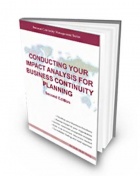BCMBoK 3: Business Impact Analysis
Body of Knowledge Menu| BoK 1 | BoK 2 | BoK 3 | BoK 4 | BoK 5 | BoK 6 | BoK 7
Certification Menu | BCCP | CMCP | CCCP | DRCP | ORCP | BCCS | CCCS | CMCS | DRCS | ORCS | BCCE | CMCE | CCCE | DRCE | ORCE | BCCA | BCCLA
Competency Level Menu
| CL 1B | CL 2B | CL 3B | CL 1C | CL 2C | CL 3C | CL 1CC | CL 2CC | CL 3CC | CL 1D | CL 2D | CL 3D | CL 1OR | CL 2OR | CL 3OR | CL 2A | CL 3A


1. Business Continuity Management Body of Knowledge 3 or BCMBoK 3 provides the minimum expectation for a BCM professional in the area of Business Impact Analysis.
- Implement business impact analysis process.
- Understand the principles and scope of the BIA process.
- Apply the BIA implementation process.
- Understand the available BIA data collection mechanisms.
- Determine and apply the appropriate BIA data collection mechanism.
- Design a custom tailored BIA questionnaire.
- Gather BIA Information.
- Identify activities that support Critical Business Functions (CBF) and identify owners.
- Determine impacts of a disruption to each activity/process across the organization that may damage organization's reputation, assets or financial position.
- Quantify timescales where interruption becomes unacceptable to the organization.
- Determine key requirement for organization-wide tolerable downtime.
- Determine Inter-dependencies and intra-dependencies.
- Identify vital records needed for recovery.
- Identify and document CBFs, critical processes and critical application.
- Determine continuity resources.
- Provide the resource information to determine or recommend Business Continuity Strategy.
- Identify internal and external resource requirements to support activities.
- Quantify the people, technology, and telephony resources required over time to maintain business activities at an acceptable level and within the maximum tolerable period of disruption.
- Seek Executive Management Approval.
- Seek sign off of requirements by process owners.
- Present requirements to executive management and seek approval to adopt the findings as the basis for determining a BC strategy.
Related Terms: Business Impact Analysis.


Body of Knowledge 3: Business Impact Analysis Definitions
BCM Audit
CL One (1) | * CL Two (2) | * CL Three (3)
Business Continuity
CL One (1) | * CL Two (2) | * CL Three (3)
Crisis Management
CL One (1) | * CL Two (2) | * CL Three (3)
Crisis Management
CL One (1) | * CL Two (2) | * CL Three (3)
Disaster Recovery
CL One (1) | * CL Two (2) | * CL Three (3)
BCM Body of Knowledge 3: Business Impact Analysis Definitions
Competency Level (CL) 1
- BCM BoK 3 (BC) Business Continuity
- BCM BoK 3 (CM) Crisis Management
- BCM BoK 3 (CC) Crisis Communication
- BCM BoK 3 (DR) Disaster Recovery
- BCM BoK 3 (A) BCM Audit
Competency Level (CL) 2
- BCM BoK 3 (BC) Business Continuity
- BCM BoK 3 (CM) Crisis Management
- BCM BoK 3 (CC) Crisis Communication
- BCM BoK 3 (DR) Disaster Recovery
- BCM BoK 3 (A) BCM Audit
Competency Level (CL) 3
- BCM BoK 3 (BC) Business Continuity
- BCM BoK 3 (CM) Crisis Management
- BCM BoK 3 (CC) Crisis Communication
- BCM BoK 3 (DR) Disaster Recovery
- BCM BoK 3 (A) BCM Audit